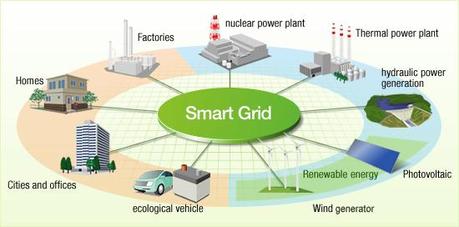
The term 'smart grid' refers to an electrical power grid that is in-fact 'intelligent'. This means it can gather information at specific intervals and make informed decisions after an analysis of this information.
The said information includes consumer, and supplier behaviors vis-a-vis availability of power on the grid. The resulting decisions/actions from the smart grid focus on improving on the efficiency, reliability, economics, and sustainability of the production and distribution of electricity (ref). A smart grid introduces the power grid to the internet, and enables the industry’s best ideas for grid modernization such as incorporating renewable energy resources to achieve their full potential. In order to make a normal power grid 'smart', its technology and infrastructure needs to be completely re-engineered from the ground up.
Research conducted in Salem, Oregon at Portland General Electric's campus was unveiled to the general public. It featured a new 5-megawatt, lithium-ion energy storage system that is poised to make the Northwest United States, and the entire nation's electric system smarter and more efficient. The battery is said to be highly reliable, and will act as a localized power source or 'micro-grid'. It will provide power to over 500 homes in South-East Oregon during intermittent blackouts.
The press release details specifics of this system:
 The energy storage system will respond to regional grid conditions with the help of a key aspect of the demonstration called transactive control. Transactive control is based on technology from DOE's Pacific Northwest National Laboratory, which is managed by Battelle. The technology helps power producers and users decide how much of the area's power will be consumed, when and where. This is done when producers and users automatically respond to signals representing future power costs and planned energy consumption. The cost signals originate at Battelle's Electricity Infrastructure Operations Center in Richland, Wash. They are updated every five minutes and sent to the project's participating utilities, including PGE.
The energy storage system will respond to regional grid conditions with the help of a key aspect of the demonstration called transactive control. Transactive control is based on technology from DOE's Pacific Northwest National Laboratory, which is managed by Battelle. The technology helps power producers and users decide how much of the area's power will be consumed, when and where. This is done when producers and users automatically respond to signals representing future power costs and planned energy consumption. The cost signals originate at Battelle's Electricity Infrastructure Operations Center in Richland, Wash. They are updated every five minutes and sent to the project's participating utilities, including PGE.Source: PNNL News
Images Top: Hitachi, Bottom: Portland General Electric, US.
